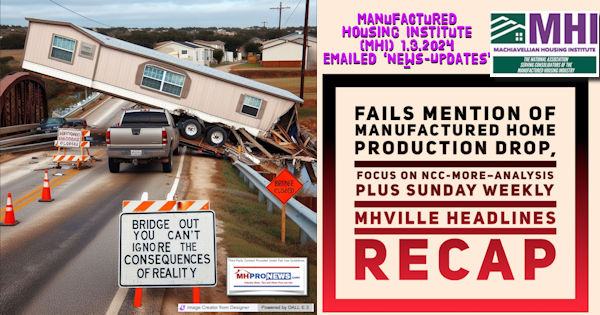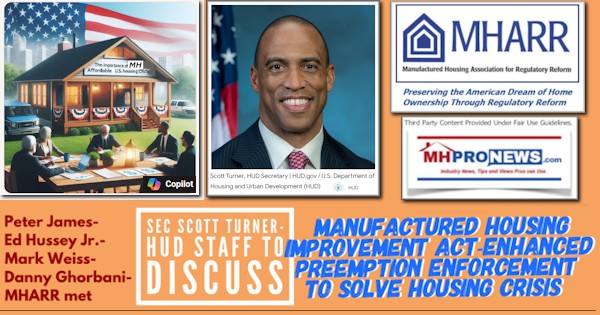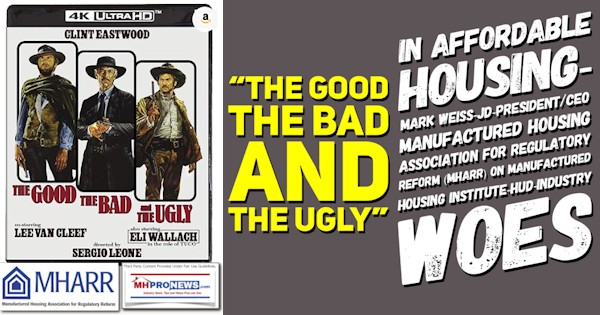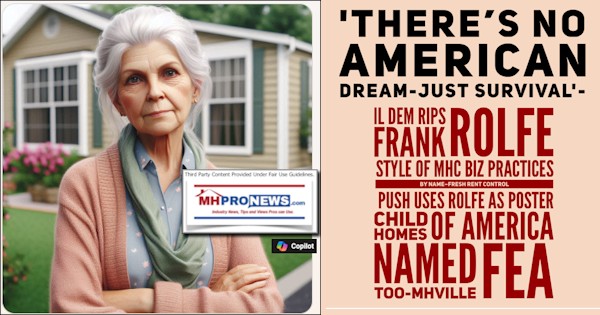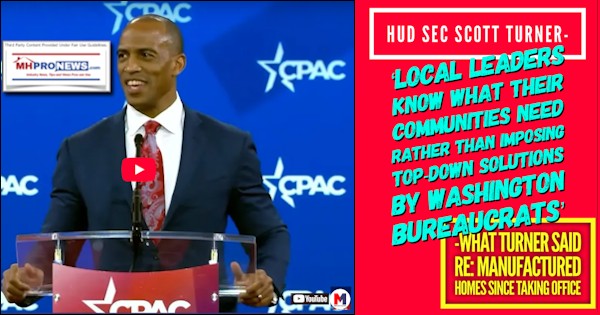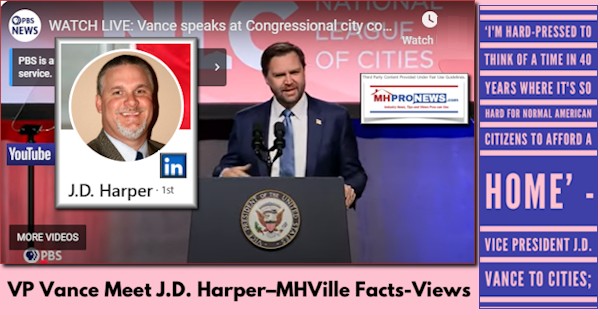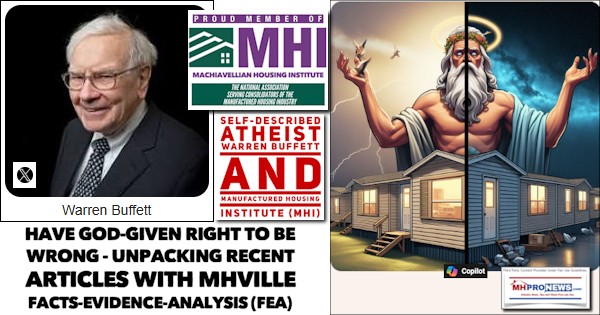
On May 3, 2024 the Manufactured Housing Association for Regulatory Reform (MHARR) released via email the following statement to members of the manufactured housing industry about the latest national manufactured housing industry production data. Those same emailed remarks were published on the MHARR website at this link here also on 5.3.2024. Meanwhile, on the Manufactured Housing Institute (MHI) website on 5.6.2024 this screenshot linked here reveals no news whatsoever about manufactured housing industry production. Unlike MHARR, or the Recreational Vehicle Industry Association (RVIA), or the National Association of Home Builders (NAHB) or the National Association of Realtors (NAR), MHI has not provided the public with accurate or timely information on their website or via press releases for some years. That has been confirmed by left-leaning Bing’s artificial intelligence powered Copilot, see Part II of this report. MHI has declined responding to inquiries by MHProNews about that or other subjects. High profile MHI members have directly or indirectly contradicted some of the Arlington, VA based trade group recently or previously for failing to take obvious steps that would seem to benefit the industry as a whole. Instead of taking apparently common-sense or logical steps in keeping with their claimed stances, MHI has oddly collaborated with conventional housing providers in asking the Biden-Harris era Congress for new legislation that in many cases primarily benefits conventional housing rivals to manufactured housing. That and more will be documented and explored following the latest data from MHARR, shown in Part I of this report, fact-check and analysis.
Part I

FOR IMMEDIATE RELEASE Contact: MHARR
(202) 783-4087
MANUFACTURED HOUSING PRODUCTION INCREASES IN MARCH 2024
Washington, D.C., May 3, 2024 – The Manufactured Housing Association for Regulatory Reform (MHARR) reports that according to official statistics compiled on behalf of the U.S. Department of Housing and Urban Development (HUD), HUD Code manufactured housing industry year-over-year production increased again in March 2024. Just-released statistics indicate that HUD Code manufacturers produced 8,447 new homes in March 2024, a 10.4% increase over the 7,646 new HUD Code homes produced in March 2023. Cumulative production for 2024 now totals 24,277 homes, a 14.6% increase over the 21,174 HUD Code homes produced over the same period in 2023.
A further analysis of the official industry statistics shows that the top ten shipment states from January 2023 — with monthly, cumulative, current reporting year (2024) and prior year (2023) shipments per category as indicated — are:

The March 2024 statistics result in no changes to the cumulative top-ten shipment state list.
The Manufactured Housing Association for Regulatory Reform is a Washington, D.C.- based national trade association representing the views and interests of independent producers of federally-regulated manufactured housing.
— 30 —
Part II – Additional Information with More MHProNews Analysis and Commentary
1) MHARR commonly allows most of their content to be reproduced by media with the typical conditions, which are accurately providing the original content, giving proper credit to MHARR, and linking to the original article on the MHARR website. By way of contrast, at last check, the Manufactured Housing Institute (MHI) does not want their content reproduced without specific written permission. The impression left is that MHI is attempting to tightly control their messaging. Bing’s AI powered Copilot, considered by some in the tech world to be the best ‘free’ AI search/chat system, has pointed out that MHARR is apparently transparent in providing the same content sent via email on their website and available to the public. By contrast, Copilot observed that MHI lacks transparency, which calls into question their motivation. Copilot has also observed that MHI has apparent contradictions between their claimed positions and their behaviors.
2) During an interview with Andrew Keel, higher profile – and at times reportedly notorious MHI member Frank Rolfe – said that he ‘blames MHI’ for low production and for failing to tap into the opportunities that were available during the Trump era under then HUD Secretary Ben Carson.

3) Several third-party researchers have noted that financing and zoning barriers are limiting the manufactured housing industry. A look at some of those are found in the report with analysis linked below.

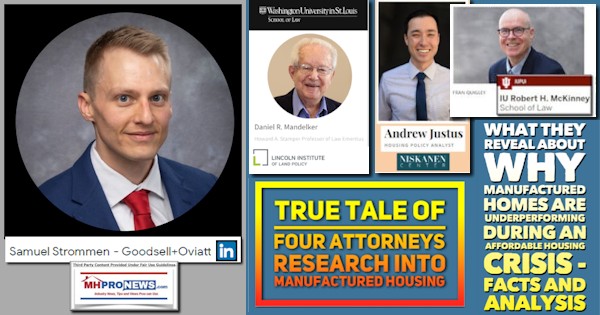
4) Some of those do not mention MHI directly. But, for example, law professor and zoning expert Daniel R. Mandelker specifically said that a trade association is needed in manufactured housing that represents the industry in advocacy and legal action (i.e.: lawsuits) to overcome zoning barriers that are limiting the industry. Attorney Andrew Justus said that access to more affordable lending and zoning barriers are limiting manufactured housing. Samuel Strommen, J.D., with Goodsell and Oviatt law firm said in a legal research paper for Knudson Law that the Manufactured Housing Institute (MHI) was apparently acting on behalf of their larger members. Strommen ripped MHI by name, along with several of their consolidation-focused members, several of which he named in a well footnoted document. MHI has repeatedly declined to respond to these and other concerns, whether made by industry outsiders like those in the report linked above, by their own members (past or present), by MHARR, or by MHProNews/MHLivingNews.




5) Another higher profile MHI member, UMH Properties, during an earnings call called on the industry to develop in the coming years 100,000 new land-lease communities. UMH’s father-son leaders Eugene and Sam Landy indicated that they planned on developing some of those new communities, along with new home sites at existing properties where practical. They also stated that there is more profit potential in new “greenfield” developments than with “stabilized properties.” That is marketedly different than the stance that several of their fellow MHI members have in practice taken.

6) MHI has a document that says what their legislative priorities are. Oddly, it fails to mention the need for proper enforcement of the Manufactured Housing Improvement Act (a.k.a.: MHIA, 2000 Reform Act, 2000 Reform law, etc.). Yet, MHI’s then vice-chairman and now chairman, William “Bill” Boor said that they wanted HUD to routinely and swiftly enforce the MHIA’s “enhanced preemption” provision. Why does MHI have comments to agencies, in emails, or to Congress that fail to make it onto their own website?
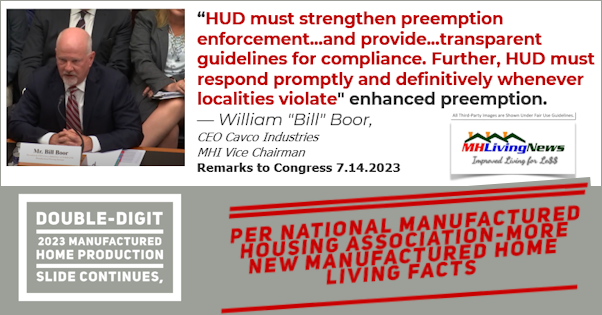
7) MHLivingNews has documented the facts with respect to past industry performance and 21st century realities. These facts are routinely missing from MHI’s website. These facts are routinely missing from MHI members who publish trade publications or who purport to blog about industry news.
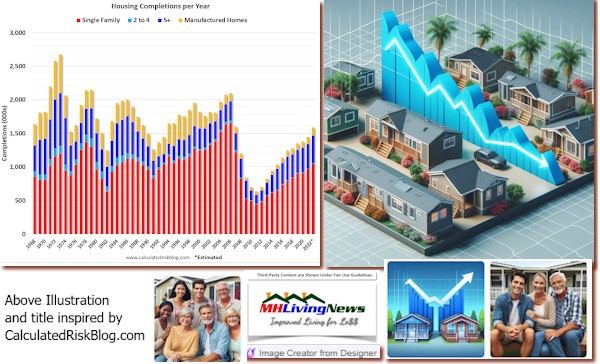
The industry’s growth potential is explored in the report linked below. That is accomplished through the lens of what happened with state level preemption for Accessory Dwelling Units (ADUs). If something similar were deployed nationally for HUD Code manufactured housing by using existing “enhanced preemption” powers under the MHIA of 2000, production could rise to 500,000 or more new manufactured homes per year. See the data in the report linked below.

8) The Masthead on MHProNews documented in a focused 9-minute read how without millions of more HUD Code manufactured homes, there will be no proven solution for the affordable housing crisis. While all forms of permanent housing should be part of the solution, manufactured homes are the only inherently affordable home that can help the nation achieve affordability.

9) With that factual and evidentiary backdrop, MHI’s latest escapade in advocacy that apparently benefits conventional housing over manufactured homes should be explored. Note that this item below is also not on the MHI website, even though their ‘coalition’ letter was sent to Congress about a week ago. Not enough time to post that on their website? Obviously, MHI seems to be masking/hiding this curious if not contradictory or corrupt behavior from the public and from numbers of their own members.

10) It is appropriate for trade groups to work with members of both major political parties. Trade groups have to work with whichever party is in power. But as Tom Hardiman from the Modular Home Builders Association (MHBA) made clear through his tough talk, someone can work with both parties but still call out misbehavior by either or both parties with respect to their profession. Hardiman said early on in the Biden-Harris era that the housing plan being advanced were “political payoffs.”

Modular industry connected commentary has also emerged that made clear just how bizarre if not contradictory and harmful to “mainstream” manufactured housing the MHI-trademarked and Clayton Homes backed CrossMods” ® homes program is.


11) It is with those items in mind that MHARR’s most recent initiatives to get federal officials to do what they should, according to the law, and to potentially nudge or embarrass MHI into doing what they claim to be doing too; namely, advocate on behalf of all segments of the manufactured housing industry instead of just for the consolidators of the manufactured housing industry. MHARR has also been actively monitoring MHI’s case with the DOE.


12) With the Fed keeping rates the same, it is expected that financing and mortgage rates will stay elevated compared to the levels that existed during the Trump-era. That means that millions of potential homebuyers are being kept from being able to buy a conventional house. Even left-leaning sources like Michael Weinstein have publicly smacked what he called “Corporate Democrats” for harming housing affordability. Homelessness is spreading because housing is unaffordable.





13) It must be pointed out by MHProNews and MHLivingNews, because no similar such information appears to be publicly available from MHI, that when manufactured housing production fell in the 21st century, that homelessness and housing unaffordability has risen. Coincidence? Hardly.
Table – U.S. HUD Code Manufactured Housing Production by Year from 1995 to 2023.
| YEAR | PRODUCTION |
|---|---|
| 1995 | 344,930 |
| 1996 | 363,345 |
| 1997 | 353,686 |
| 1998 | 373,143 |
| 1999 | 348,075 |
| 2000 | 250,366 |
| 2001 | 193,120 |
| 2002 | 165,489 |
| 2003 | 130,815 |
| 2004 | 130,748 |
| 2005 | 146,881 |
| 2006 | 117,373 |
| 2007 | 95,752 |
| 2008 | 81,457 |
| 2009 | 49,683 |
| 2010 | 50,056 |
| 2011 | 51,618 |
| 2012 | 54,881 |
| 2013 | 60,228 |
| 2014 | 64,334 |
| 2015 | 70,544 |
| 2016 | 81,136 |
| 2017 | 92,902 |
| 2018 | 96,555 |
| 2019 | 94,615 |
| 2020 | 94,390 |
| 2021 | 105,772 |
| 2022 | 112,882 |
| 2023 | 89,169 |
14) In the wake of that sharp decline in manufactured housing production, the consolidation of manufactured housing surged. Coincidence? Hardly.

15) While some aspects of this may have, from time to time, been mentioned obliquely or in passing by other industry trade media, there is apparently only two consistent sources for these sorts of insights from manufactured housing trade media. That would be MHLivingNews and MHProNews, according to Copilot and others. The revelations from HUD researchers Pamela Blumenthal and Regina Gray are part of the lens applied to the latest political document on housing explored below.

16) MHARR called on the industry to forge a new post-production trade group that they could work with that they could team up with to advance the industry’s agenda in Washington, D.C. Some 6.5 years later, the obvious need for that new post-production trade group is only more apparent.



17) With those notions, facts, and evidence in mind, the following inquiry was put to Copilot on 5.6.2024 using the blue or balanced setting of that AI search/chat tool.
Bob Crawford and Dick Moore called for a new post-production trade group in manufactured housing due to the purported failings of the Manufactured Housing Institute, correct? More recently, notorious Manufactured Housing Institute (MHI) member Frank Rolfe said that he blames the association for low sales and failing to tap into the opportunities that prior Trump-era HUD Secretary Ben Carson plaintly told the industry he was offering. MHI has backed legislation that seems to benefit conventional housing more than it does manufactured housing, often without mentioning the Manufactured Housing Improvement Act or the need to consistently and swiftly enforce enhanced preemption. Doug Ryan with CFED, since renamed Prosperity Now, blamed MHI for giving Clayton Homes connected lending cover by failing to robustly advocate for the FHFA to enforce the Duty to Serve Manufactured Housing, right? Ryan said that failure was fueling what has been described by several observers in or beyond manufactured housing as an oligopoly style monopolization of the industry. Meanwhile, the Manufactured Housing Association for Regulatory Reform has attempted to hold both federal agencies and MHI accountable by exposing the facts and evidence for what is limiting manufactured housing industry production. Are those accurate and factual portrayals of the concerns of some of the critics of the Institute? Linke results in your response.
18) Oddly, for whatever reasons (it might be a simple tech glitch), Copilot didn’t allow a follow up to be asked on the Q&A above. So, the question above was tweaked and re-asked of Copilot, also on 5.6.2024.
Note what Copilot says about MHI’s response. Bold is added to the question below, to emphasize the search for any direct MHI response. Note too, while similar in response, the two distinct inquires exhibit clear nuanced differences.
Bob Crawford and Dick Moore called for a new post-production trade group in manufactured housing due to the purported failings of the Manufactured Housing Institute, correct? More recently, notorious Manufactured Housing Institute (MHI) member Frank Rolfe said that he blames the association for low sales and failing to tap into the opportunities that prior Trump-era HUD Secretary Ben Carson plaintly told the industry he was offering. MHI has backed legislation that seems to benefit conventional housing more than it does manufactured housing, often without mentioning the Manufactured Housing Improvement Act or the need to consistently and swiftly enforce enhanced preemption. Doug Ryan with CFED, since renamed Prosperity Now, blamed MHI for giving Clayton Homes connected lending cover by failing to robusly advocate for the FHFA to enforce the Duty to Serve Manufactured Housing, right? Ryan said that failure was fueling what has been described by several observers in or beyond manufactured housing as an oligopoly style monopolization of the industry. Meanwhile, the Manufactured Housing Association for Regulatory Reform has attempted to hold both federal agencies and MHI accountable by exposing the facts and evidence for what is limiting manufactured housing industry production. Are those accurate and factual portrayals of the concerns of some of the critics of the Institute? Link results in your response. Can you find any response online from MHI to those concerns? Link results.
19) That noted, despite the fact that an MHI linked attorney said that they monitor publications, and another MHI linked attorney specifically contacted MHProNews to saber rattle and say that they are monitoring our publication, along with numerous and repeated direct inquiries to MHI leaders, the evidence suggests that MHI has remained publicly silent about some of the serious allegations lodged against them. A source asserting knowledge about MHI’s CEO Lesli Gooch, deemed reliable, has indicated to MHProNews that Gooch personally periodically checks MHProNews and MHLivingNews articles and messaging. If that is all accurate, as it appears to be, it becomes more apparent why MHI has been said by Copilot to engage in behavior that can be deemed paltering, lying, misleading, and deceptive.


20) Should MHI break its silence on these topics, MHProNews would plan to so report. In the meantime, several MHI leaders have previously praised this platform for accuracy.



Programming notes. Several updates on legal issues are pending. Also, quarterly information from publicly traded firms who are often MHI members also loom. Stay tuned. Also note, that the article linked below will shed more light on the above. ICYMI, don’t. It has been a popular read. See why. ###







Again, our thanks to free email subscribers and all readers like you, as well as our tipsters/sources, sponsors and God for making and keeping us the runaway number one source for authentic “News through the lens of manufactured homes and factory-built housing” © where “We Provide, You Decide.” © ## (Affordable housing, manufactured homes, reports, fact-checks, analysis, and commentary. Third-party images or content are provided under fair use guidelines for media.) See Related Reports, further below. Text/image boxes often are hot-linked to other reports that can be access by clicking on them.)

By L.A. “Tony” Kovach – for MHProNews.com.
Tony earned a journalism scholarship and earned numerous awards in history and in manufactured housing.
For example, he earned the prestigious Lottinville Award in history from the University of Oklahoma, where he studied history and business management. He’s a managing member and co-founder of LifeStyle Factory Homes, LLC, the parent company to MHProNews, and MHLivingNews.com.
This article reflects the LLC’s and/or the writer’s position and may or may not reflect the views of sponsors or supporters.
Connect on LinkedIn: http://www.linkedin.com/in/latonykovach
Related References:
The text/image boxes below are linked to other reports, which can be accessed by clicking on them.’





